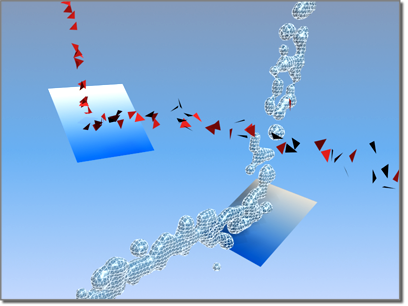The Deflector space warp acts as a planar shield to repel the particles generated by a particle system. For example, you can use Deflector to simulate pavement being struck by rain. You can combine a Deflector space warp with a Gravity space warp to produce waterfall and fountain effects.

Two streams of particles striking two deflectors
Procedures
To create a deflector:
- On the
 Create panel, click
Create panel, click  (Space Warps). Choose Deflectors from the list, then on the Object Type rollout, click Deflector.
(Space Warps). Choose Deflectors from the list, then on the Object Type rollout, click Deflector. - Drag in a viewport to define the deflection area.
The deflector appears as a wireframe rectangle.
- Apply the deflector to the particle system using the appropriate method:
- If using Particle Flow, specify the deflector in the Collision test or Collision Spawn test parameters.
- If using a non-event-driven particle system,
 bind the particle system to the deflector icon.
bind the particle system to the deflector icon.
Interface

The deflector's effect is controlled mainly by its size and orientation in the scene, relative to the particle system that is bound to it. You can also adjust how strongly the deflector deflects particles.
- Bounce
-
Controls the speed at which particles bounce off the deflector. At a setting of 1.0, particles bounce off the deflector at the same speed they struck it. At 0.0, particles do not bounce at all. At values between 0.0 and 1.0, particles bounce off the deflector at a speed reduced from their initial speed. At values greater than 1.0, particles bounce off the deflector at a speed greater than their initial speed. Default=1.0.
- Variation
-
The amount by which each particle can vary from the Bounce setting.
- Chaos
-
The amount of variation from the perfect angle of reflection (found when Chaos is set to 0.0). 100% induces a variation in reflection angle of up to 90 degrees
- Friction
-
The amount by which particles are slowed as they move along the deflector surface. A value of 0% means they're not slowed at all. A value of 50% means they're slowed to half their original speed. A value of 100% means they stop moving when they strike the surface. Default=0%. Range=0% to 100%.
Tip: To have particles slide along a deflector surface, set Bounce to 0. Also, unless influenced by a force such as Wind or Gravity, particles meant to slide should strike the surface at an angle other than 90 degrees. - Inherit Vel
-
(Velocity Inheritance) When the value is greater than 0, the motion of the deflector affects particles as well as the other settings. For example, if you want an animated SDeflector passing through an array of particles to affect the particles, turn up this value.
- Width
-
Sets the deflector's width.
- Length
-
Sets the deflector's length.